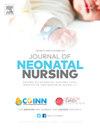西奥罗米亚三级医院低温和呼吸窘迫综合征入院新生儿死亡率预测因素,回顾性随访研究,2023
Q2 Nursing
引用次数: 0
摘要
背景:新生儿体温过低与呼吸窘迫综合征之间存在相关性,这两种情况都会导致新生儿死亡率升高。本研究旨在确定在西奥罗米亚转诊医院入院的低体温和呼吸窘迫综合征新生儿的死亡率及其预测因素。方法对385例新生儿进行回顾性随访研究。通过简单的随机抽样技术选择参与者,并使用结构化检查表收集数据。为了进行清理和编码,将数据输入EpiData版本4.6.0.2,并导出到STATA版本14进行分析。使用Kaplan-Meier曲线估计生存时间。p值为<;0.05的变量被认为是死亡率的显著预测因子,并拟合威布尔回归模型来确定死亡预测因子。结果385例因低温合并呼吸窘迫综合征住院的新生儿中,149例(38.7%);95% CI: 33.9-43.7)死亡,死亡率为每1000个新生儿日观察64.1例(95% CI: 54.6-75.3)。中位生存天数为11天(95% CI: 9-23)。体温32°C (AHR:3.3 (95% CI: 1.5-6.5))、多胎妊娠(AHR:2.3 (95% CI:1.43.6))、NEC (AHR:2.8(1.7 - 4.75))、出生体重1500gm (AHR:3.98(1.7 - 10))和1500-2499gm (AHR:2.6 (95% CI: 1.3-5.9))、出生损伤(AHR:1.9 (95% CI: 1.3-3.1))、第5分钟Apgar评分<;3 (AHR:5.4 (95% CI:1.9 - 16.8))和4-6 (AHR:1.7 (95% CI: 1.1-2.7))、低血糖(AHR:1.8 (95% CI: 1.14-2.9))是死亡的预测因子。相比之下,产前皮质类固醇(AHR:3.03 (95% CI: 1.12-8.6))对死亡有保护作用。结论新生儿呼吸窘迫综合征合并低温死亡率高。体温低于32℃、出生体重、低血糖、低出生体重和多胎妊娠会增加死亡风险;另一方面,产前皮质类固醇可降低死亡风险。本文章由计算机程序翻译,如有差异,请以英文原文为准。
Predictors of mortality among neonates admitted with hypothermia and respiratory distress syndrome at West Oromia tertiary hospitals, Retrospective Follow-up Study, 2023
Background
There is a correlation between neonatal hypothermia and respiratory distress syndrome, and both conditions contribute to higher neonatal death rates. This study is aimed at identifying the mortality rates and the predictors among neonates admitted with admission hypothermia and respiratory distress syndrome at West Oromia Referral hospitals.
Methods
Institution based retrospective follow-up study design was conducted among 385 neonates. Participants were selected by a simple random sampling technique, and data were gathered using a structured checklist. For cleaning and coding the data was entered into EpiData version 4.6.0.2 and exported to STATA version 14 for analysis. Survival time was estimated using the Kaplan–Meier curves. Variables with a P-value <0.05 were considered significant predictors of mortality, and the Weibull regression model was fitted to determine the predictors of death.
Result
Out of the 385 neonates hospitalized due to hypothermia and respiratory distress syndrome, 149 (38.7 %; 95 % CI: 33.9–43.7) of them died with a mortality rate of 64.1 per 1000 neonate-day observations (95 %CI: 54.6–75.3). The median survival days of 11 days (95 % CI: 9–23). A temperature <32 °C (AHR:3.3 (95 % CI:1.5–6.5)), multiple pregnancies (AHR:2.3 (95 % CI:1.43.6)), NEC (AHR:2.8 (1.7–4.75)), birth weight of <1500gm (AHR:3.98 (1.7–10)) and 1500-2499gm (AHR:2.6 (95 % CI:1.3–5.9)), birth injury (AHR:1.9 (95 % CI:1.3–3.1)), Apgar score at the fifth minute <3 (AHR:5.4 (95 % CI:1.9–16.8)) while 4–6 (AHR:1.7 (95 % CI:1.1–2.7)), hypoglycemia (AHR:1.8 (95 % CI:1.14–2.9)) were predictors of death. In contrast, an antenatal corticosteroid (AHR:3.03 (95 % CI:1.12–8.6)) had a protective effect against death.
Conclusion
Neonates with respiratory distress syndrome and hypothermia had a high mortality rate. The risk of death is increased by body temperature below 32 °C, birth weight, hypoglycemia, low birth weight, and multiple pregnancies; on the other hand, antenatal corticosteroids decrease the hazard of death.
求助全文
通过发布文献求助,成功后即可免费获取论文全文。
去求助
来源期刊

Journal of Neonatal Nursing
Nursing-Pediatrics
CiteScore
2.00
自引率
0.00%
发文量
143
期刊介绍:
Aims & Scope: This is the practical, bimonthly, research-based journal for all professionals concerned with the care of neonates and their families, both in hospital and the community. It aims to support the development of the essential practice, management, education and health promotion skills required by these professionals. The JNN will provide a forum for the exchange of ideas and information between the range of professionals working in this field; promote cooperation between these professionals; facilitate partnership care with families; provide information and informed opinion; promote innovation and change in the care of neonates and their families; and provide an education resource for this important rapidly developing field.
 求助内容:
求助内容: 应助结果提醒方式:
应助结果提醒方式:


